WE CONVEY A GREENER FUTURE
AUMUND has been bringing together ecology and business for decades
“The linking of ecological aspects and business considerations, for the benefit both of our customers and of the AUMUND Group itself, has defined our thinking and actions for decades, in fact even before concepts such as conservation, sustainability and reduction of CO2 emissions became important for so many companies all over the world. This is another area in which the AUMUND Group belongs to the forerunner in the bulk materials handling sector” says Franz-W. Aumund.
„WE CONVEY A GREENER FUTURE“ – This is the slogan which headlines two areas of activity where the AUMUND Group unites ecology and business:
The product companies AUMUND, SCHADE, SAMSON, EUROSILO and TILEMANN support our customers on their journeys to environmentally conscious production processes, and activities which comply with environmental legislation. Our customers benefit from solutions based on exceptional technological expertise and comprehensive knowledge of the industries and regional markets we serve, and delivered by our Research & Development team.
The AUMUND Group takes its responsibility for conservation of resources and protection of the environment seriously on its own sites as well. As an example, no fossil fuels are utilised in machinery manufacture, and additional measures are consistently being undertaken to save energy.
…..
Energy intensive industries such as cement benefit from AUMUND solutions which reduce carbon footprint.
…..
Lowering operating costs and reducing climate-damaging CO2: the most energy intensive sectors such as the cement industry, the steel industry, and power stations, are being called upon to adopt extremely climate-friendly processes, and they are seeking the most cost-effective solutions in order to achieve this. AUMUND Fördertechnik is well-positioned to provide these solutions, as will be shown by the following examples.
AU-MILL® shreds, dries and separates caloric plastic waste
The AUMUND Fuel Mill, AU-MILL® processes calorific plastic waste, known as RDF (Refuse Derived Fuel) for use as an alternative fuel in place of coal, for example in cement production, an industry which is responsible for around 8% of global carbon dioxide emissions. Two groups of customers benefit from this technology, waste processing providers who supply the prepared plastic material in bales to their industrial customers, and customers who themselves treat the waste for use in their own processes.

A range of products for transporting alternative fuels can be found in AUMUND solutions such as the Trailer Docking Station, the Walking Floor, the Screw Discharger, and a specially modified Drag Chain Conveyor. The alternative fuels handled are categorised into two groups. The first of these is CO2-neutral biomass such as wood chips, wood pellets, sunflower seeds, coconut shells, soiled straw and hay as well as sewerage sludge. The second large group comprises materials such as plastic, used tyres, refuse from the medical sector and textile manufacture, shredded paper and animal meal.
…..
“Green Steel”: With Hot Material and Cooling Conveyors for Direct Reduction products, AUMUND Metallurgy plays a role in the reduction of CO2 in the iron and steel industry.
…..
Sustainable Hot Material Conveying as well as DRI and HBI Cooling
AUMUND is the technology leader in Hot Material Conveying, and in the cooling of the Direct Reduction products, DRI (Direct Reduced Iron) and HBI (Hot Briquetted Iron), the use of which reduces consumption of sinter and coke in blast furnaces. AUMUND conveyors contribute to the benefit of the customer in the reduction of CO2 emissions in the iron and steel industry.

Sustainable transport of LC3 cement
This AUMUND know-how from the metallurgical process also works to the advantage of the cement industry, which is working on the development of LC3 cement (Limestone Calcinated Clay Cement). The blending in of calcinated clay produces emissions of up to 40% less carbon dioxide. With Cooling Conveyors from AUMUND the burnt, calcinated clay can be cooled down from 800°C to 100°C, at which point it can be mixed with the clinker and milled to become LC3 cement. Cooling takes place in an inert atmosphere which can be created with nitrogen from an air separation unit.
Sustainable production of Chains and Components in conveying technology
On site at the TILEMANN Chains & Components product company, environmental awareness also prevails, as it follows in the footsteps of AUMUND, saving 33% of gas consumption by installing ceiling ventilators in the works halls. The lighting was also converted to LED as it was at AUMUND. Cooling fluids previously utilised in fabrication were replaced with more up-to-date and ecological alternatives. The abrasives used are also environmentally-friendly and do not pose a health hazard for the employees, and only re-useable packaging is used by TILEMANN.

…..
An AUMUND Innovation, the “Push Chain Bucket Elevator” saves CO2 and reduces CAPEX and operating costs.
…..
Innovations to support sustainable processes
Protected by a patent, the Push Chain Bucket Elevator won the AUMUND Innovation prize for its developer, AUMUND engineer Oliver Heine. What makes this invention so clever is that the Push Chain Bucket Elevator conveys with thrust rather than traction (pushing as opposed to pulling). The drive station is not where it usually is in the bucket elevator head, but in the bucket elevator boot. This design has more than one effect from an environmental point of view. Construction with less material saves just under 10% of energy for the same lifting capacity; in operation and extraction, more than 12%. Compared to bucket elevators of typical size and design, the savings potential of the Push Chain Bucket Elevator is around 78 t of CO2 per year, this corresponds to 37 flights from Berlin to New York and back. An AUMUND project entitled “Development of an energy-saving Push Chain Bucket Elevator for environmentally-friendly vertical conveying of bulk materials” is funded in part by a grant from the German Federal Foundation for the Environment. Because with the Push Chain Bucket Elevator greater lifting heights and inclines can be achieved than are possible with conventional bucket Elevators, this innovation is not only interesting for the cement industry but also for the iron and steel industry and for minerals and mining.
Another important aspect from the point of view of application opportunities is that by relocating the drive from the head to the boot, the centre of gravity of the Bucket Elevator is transferred to the boot. This is a significant advantage when installing bucket elevators on ships for example.

…..
SCHADE und SAMSON
fulfil the strict environmental protection requirements of their customers, with solutions for dust reduction.
…..
Roofed storages to minimize dust emission
For reduction of dust emissions, and for other reasons of environmental safety, SCHADE offers covered storage systems for bulk materials volumes of 800,000 t or 1,000,000 m3 even on a small surface area. Stockpiling is carried out by mobile Tripper Cars installed beneath the roof of the storage building, and the pile is reclaimed by Full-Portal or Semi-Portal Reclaimers. Depending on customer requirements or official regulations, the equipment can be adapted to the height of the storage building using a design incorporating two booms on the Reclaimer. In an indoor circular storage facility, storage capacities of 360,000 t are achievable.
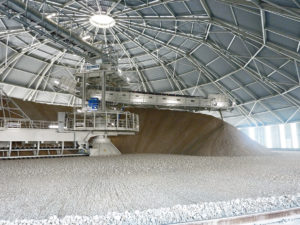
Eco Hoppers with dust protection features
The SAMSON Eco Hopper fulfils strict standards for the reduction of dust emissions. The Eco Hopper is used for importing bulk materials in ports and terminals, and has a comprehensive range of dust protection features, including a system which reduces the impact of sidewinds, and the Flex-Flap dust sealing system. The latest addition is a mechanically driven sliding roof. The four-part roof is fabricated in corrugated aluminium and is mounted on steel rails.

Lowering energy costs with AUMUND is nothing new
Traditionally, raw meal and clinker silos in the cement industry had been filled using pneumatic conveying techniques. In the 1970s, however, even before concepts such as sustainability and CO2 emissions became significant, mechanical conveying with AUMUND Bucket Elevators began to take over. An important sales argument even then was that with AUMUND technology, three to four times less energy is consumed than with pneumatic conveying, which has seen AUMUND Bucket Elevators occupy the position of international state of the art for vertical conveying of bulk materials for many years.
…..
On home soil AUMUND also practices environmental awareness.
…..
On its own sites AUMUND has been showing good examples of environmental responsibility for a long time.
…..
No gas is needed as an energy source in the production of AUMUND machines, which has a positive effect on our carbon footprint.
…..
At the AUMUND headquarters in Rheinberg the office and production facilities are fitted out with energy-optimised features, such as thermal insulation, energy-saving LED lighting, ventilators which prevent heat rising to areas where it would be wasted, such as up to the factory roof.
The production facilities do not generate CO2, because AUMUND does not use gas. Back in 2010 AUMUND invested several million Euro in a sustainable future, installing solar panels on the roofs of 9 of its production halls, which makes AUMUND a generator of on average around 700,000 kWh annually. This is far more electricity than is required for its own purposes, and a large portion is sold on to the local energy provider.
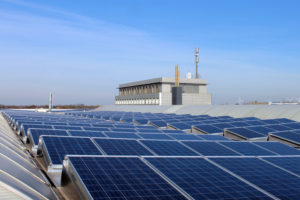

Water drainage system to filter surface water
Another investment which went into the millions was the precipitation water drainage system project, which was completed early this year in the AUMUND Industrial Park. This environmental protection measure started in September 2020 and diverts rainwater, which previously went into the ground water through seepage shafts, through a living soil area with planted percolation basins, troughs and surfaces. The seepage shafts in the production halls were also overhauled. A previously installed sedimentation unit was incorporated to filter and clarify the surface water.
Products & Systems
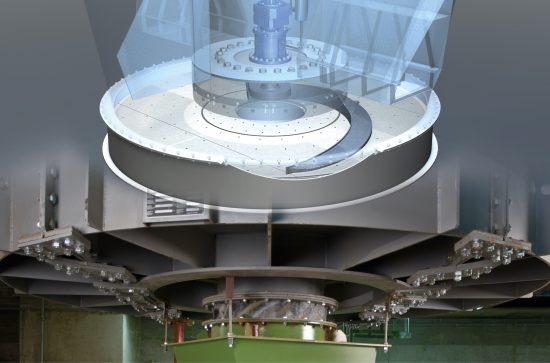
Discharge Systems

Bucket Elevators

Chain Conveyors

Apron Feeders
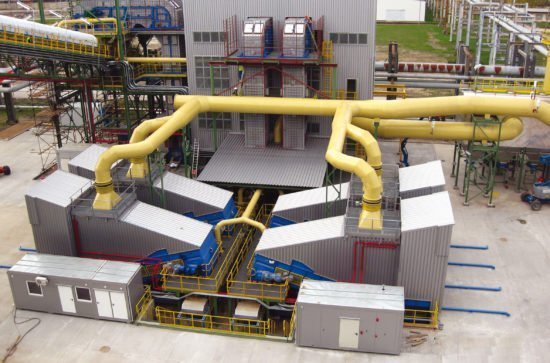
SAMSON® Material Feeder (fixed)

Samson® Material Feeders (mobile)

Pan Conveyors
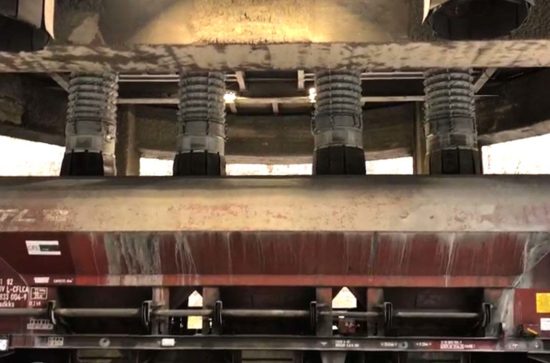
Telescopic Spouts
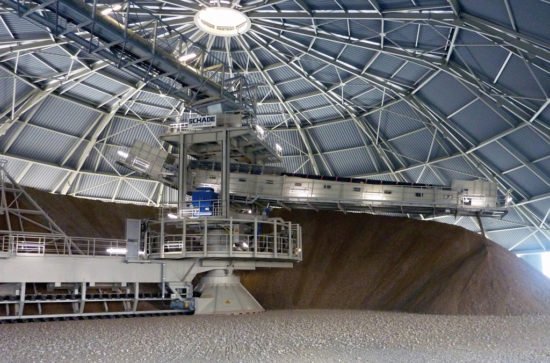
Circular Storage

Longitudinal Storage

Stackers, Reclaimers & Combined Machines

Wagon Unloading Systems & Wagon Tipplers
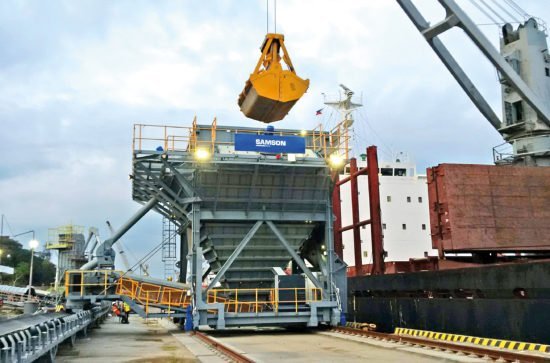
Eco Hoppers

Shiploader
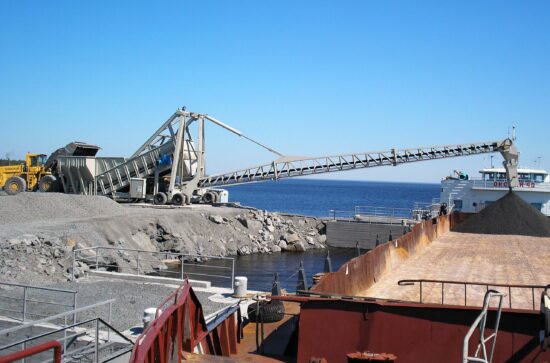
STORMAJOR®







